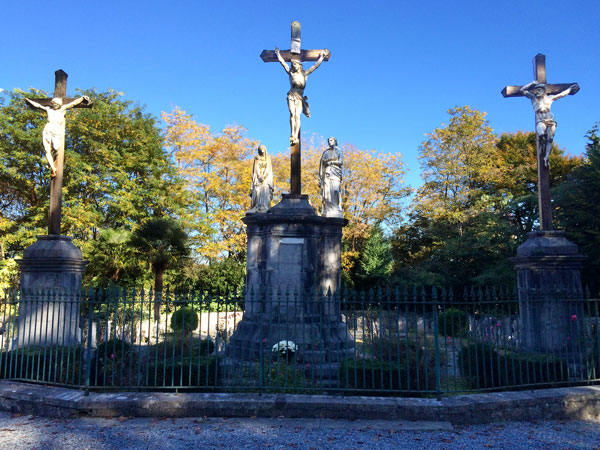The Calvary of Betharram (8)
Oh Holy Hill of Betharram!
The beautiful esplanade at the end of the Stations of the Cross, by its height, its remoteness, its dominant viewpoint over the plains, makes an exceptional place to pray: it had always been given particular attention, since the time of H. Charpentier. In 1812, the three crosses were given wooden statues of Christ and the two thieves; but due to the effect of the bad weather, they fell down in 1836. Terracotta statues replaced them in 1839; they didn’t last. From 1864, Fr Chirou (appointed Superior General of the Society of Sacred Heart Fathers, by the Bishop, after the death of St Michael Garicoïts) undertook the restoration of the three crosses, or ‘Calvary’ as it is properly known. The five large statues made of cast iron, that can be seen today at the East side of the esplanade, were ordered: the statue of Christ on the cross, those of the two thieves and of St John at the foot of the cross, the statue of the Virgin Mary standing under the cross. Fr Etchécopar was able to write in March 1867: “Calvary is becoming more beautiful; the crucifixion set makes a great impact.”The same year, work continued on the last four stations. The 13th Station is pondered in front of a Pietà in Carrara Marble. Among the actors of Calvary, a place had to be found for another character, as in the life of Christ: opposite the Pietà, Mary Magdalene lets her hair down in the shade of large beech trees. Monsignor Lacroix, however, judged the first constructions to be insufficient and he encouraged Fr Chirou to undertake a larger and more beautiful layout.

That is how the construction of the Chapel of the Resurrection began from 1867.We know what a gem owes to the beauty to its setting. This was sadly not the fortune of the bas-reliefs of Renoir. “The old-style chapels,” said Fr Vignolles, “were just poor quality, narrow, inelegant shelters, without even the least architectural character. They allowed an overpowering light to shine in distorting the images and spoiling the harmony.” Fr Garicoïts having passed away, the task of knocking down the “poor shelters” and thinking up a more worthy setting fell to Fr Chirou and his colleagues. The years 1867-1873 engraved on the site of ‘Calvary’ that image which from then on became inherent, the first thing that strikes the traveller, a row of white chapels which provide meditative thought along the way of the cross, like Rosary beads. They were conceived by an architect of 25 years, Fr Basilde Bourdenne SCJ.‘Calvary’, envisaged by H. Charpentier in 1623, was completed two and a half centuries later, in 1873. The job being finished, one of the main workers, Fr Chirou, died on 29 August 1873. Everything was already settled for the official opening on 14 September, under the chairmanship of Monsignor Lacroix. Betharram was the scene of unforgettable celebrations. Between twenty and twenty five thousand faithful, according to Fr Etchécopar, had hurried there, surrounding all the Bishops of the Province. Throughout more than eight days, prayers, songs, speeches and fanfares followed each other. Everyone could join in with the exclamation of one of the most noted speakers, Fr Caussette of Toulouse: “Oh Holy Hill of Betharram! Who has so often seen crosses fall, and crosses raised, in our country … preordained land, so loved by Mary, … how good it is to pray, to remember and to hope on this high ground.”
Raymond Descomps scj
(1916 - 2009)
Document Actions








